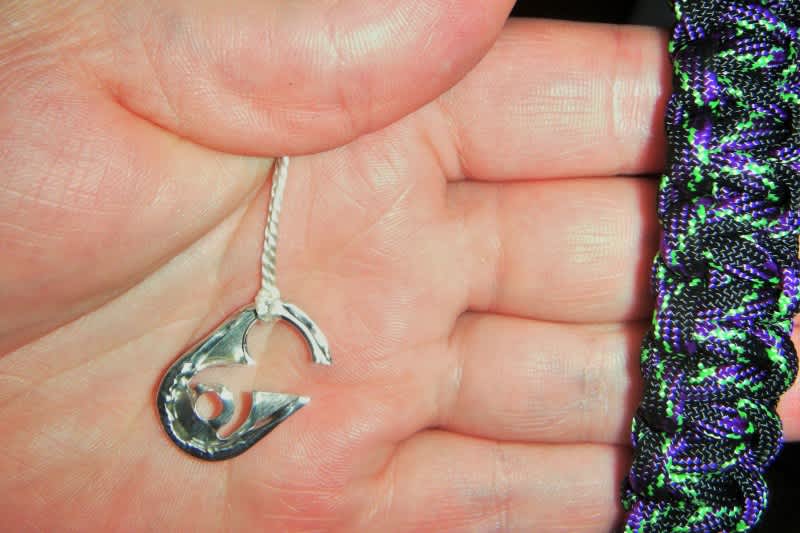How to Make Improvised Fishing Gear in a Crisis
OutdoorHub Social 04.28.16

Even the most thorough and experienced sportsman is sometimes faced with less than ideal situations despite meticulous planning. It could be that something simple and easy to rectify goes wrong and you’re back in business before you know it, or you may find yourself hungry during an unanticipated extension of a weekend in the woods. Whatever the case, you’re going to have to fend for yourself, sometimes without the gear to do so.
Fishing is a good way to feed yourself in a pinch. Provided you have access to a body of water, chances are good that you would be able to reel something in except that a shortage of gear makes reeling of any kind pretty difficult. This is why brainstorming to catch a fish without common gear could mean having a full belly and thus energy to get out of a predicament, or an empty one and depleted energy that leads to a struggle to survive.
In order to catch fish, some sort of hook is useful. Although finding an actually hook cast aside by fishermen past may be possible, it is not something you can count on by any means. What may come to your rescue is the tendency of people to leave trash strewn about. In particular you should look for soda or beer cans with an intact tab atop the can. By making a cut in the tab, you can create a makeshift hook that will be just enough to hold a bit of bait and pull a small meal ashore.
Improvising a hook does not end there. If you happen to have a safety pin, that can also be used. The same holds true for plants and trees with large thorns such as a honey locust; find a section with a thorn growing at a favorable angle and use it to catch a bite. It is even possible to use sections of tree branches where growth splits off, creating a hook-like angle. Also, when all else fails, you can whittle away at a stick until you’ve come up with an adequate design.
After engineering a way to snag a fish, you’re going to need to come up with a sturdy, makeshift line. The key thing to remember is that it must be strong enough that it won’t break. This could mean using your shoelaces or tying together some weeds or vines if need be, but ideally you will have a handy dandy piece of paracord to use. Paracord has several internal strands that are perfect for a situation such as this. Simply take the bracelet apart and pull a few strands free. The tensile strength of these strands is about 50 pounds, making it perfect for devising fishing line.
With a hook and line ready to go, next you need to make it appealing to fish. You can dig for worms or other insects to use as bait and should be able to find something in warm, moist areas. Alternately you can make a lure out of something shiny, such as a piece of metal from a discarded can or a button off your shirt. Just keep in mind the environment in which you are fishing (dark, murky water versus clear water, for example) and appeal to inhabitants as best you are able, then set your line and cross your fingers.
Despite being able to engineer a hook and line on the fly, sometimes that is not going to be enough. For example, it is much more difficult to catch a fish of significant size with improvised gear. Larger fish can break a makeshift rig or come off before you’re able to pull them ashore. In a case such as this, you might need to quite literally take matters into your own hands.
Hand grabbing or noodling is an option for landing catfish, but it is not for the faint of heart. Pulling this off sometimes requires going beneath the surface and sticking your hand into a hole in hopes a catfish will latch on. You may then face a catfish that puts up a fight, trapping you underwater for a length of time. Catfish dens are also often surrounded by sticks and logs that can shift and trap you or snag clothing if you’re not careful. If you’re going to attempt, you need to be prepared for scenarios such as this and able to deal with them as they occur. It is also imperative that you’re able to identify and thwart venomous snakes as they tend to prefer the same quarters.
Last but not least is the option to fashion a spear for fishing. Any durable branch will serve you well, but whittling it to a sharp point is necessary prior to use. This method does require a certain amount of skill and may result in frustration, so mentally prepare before setting out. Remind yourself that patience is a fishing virtue, then aim carefully and deliberately at your target.
No one wants to find themselves up a creek without a fish to eat or fishing gear to catch a meal, but a little ingenuity can go a long way. The more open minded you are about potential uses for items you may find in nature, the better off you’ll be. Scan your surroundings for useful items as well as taking an inventory of items on your person and you just might find a dinner of fish filling you up after all.

